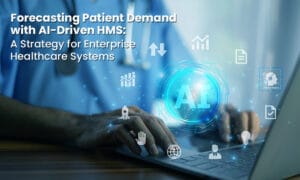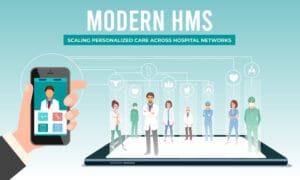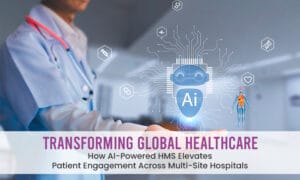
The healthcare landscape is rapidly evolving, driven by technological advancements and shifting patient expectations. As we look towards 2025-2026, several key trends are emerging, promising to reshape how healthcare is delivered and experienced.
This blog explores these futuristic trends and how innovative healthcare software solutions are poised to revolutionise operations in hospitals, clinics, daycare centres, pharmacies, and beyond. We’ll delve into how these technologies will impact workflow, finances, patient-doctor engagement, and trust-building, while also addressing potential roadblocks and strategies for overcoming them.

The Evolving Healthcare Landscape: Key Trends for 2025-2026
The healthcare sector is on the cusp of a major transformation, fuelled by cutting-edge technologies and a growing emphasis on patient-centric care. Several trends are converging to create a new paradigm in healthcare delivery:
1. Artificial Intelligence (AI) in Healthcare
AI-powered healthcare software solutions are revolutionising various aspects of patient care and hospital management. AI algorithms of these hospital management system software analyse large volumes of patient data to detect diseases early, recommend personalised treatments, and automate administrative tasks.
Applications of AI in Healthcare Software Solutions:
- Predictive Analytics: AI-driven analytics can forecast disease outbreaks, patient admissions, and treatment outcomes, enabling proactive healthcare management.
- Medical Imaging & Diagnostics: AI enhances accuracy in diagnosing conditions such as cancer, heart disease, and neurological disorders.
- Virtual Assistants & Chatbots: AI-powered chatbots provide round-the-clock patient support, answering queries, scheduling appointments, and offering medication reminders.
- Automation in Administration: AI automates billing, claims processing, and documentation, reducing human errors and administrative burdens.
To know more about AI-driven diagnostics, check out this article – The Future of Specialty Care Management with Technology Integration.
2. Telemedicine and Remote Patient Monitoring
Telemedicine has emerged as a crucial component of modern healthcare, providing virtual consultations and remote monitoring to patients across the globe.
Benefits of Telemedicine Based Healthcare Software Solutions:
- Increased Accessibility: Patients in remote or underserved areas can connect with specialists without travelling long distances.
- Time and Cost Savings: Virtual consultations save both patients and healthcare providers time and resources.
- Improved Chronic Disease Management: Remote patient monitoring present in the hospital management system software allows healthcare providers to track patients with chronic conditions, ensuring timely interventions.
- Enhanced Doctor-Patient Engagement: Virtual consultations foster continuous patient interactions, improving trust and treatment adherence.
3. Wearable Health Technology and Internet of Medical Things (IoMT)
The integration of IoT in healthcare, known as the Internet of Medical Things (IoMT), is making healthcare more data-driven and personalised. Wearable health devices, such as smartwatches and fitness trackers, continuously monitor health parameters and send real-time data to healthcare providers.
Key Features of IoMT in Healthcare:
- Continuous Monitoring: Devices track heart rate, oxygen levels, blood pressure, and glucose levels, providing real-time insights.
- Early Detection of Health Issues: AI-powered analytics of the hospital management system software detect anomalies, enabling early intervention and preventing complications.
- Improved Patient Engagement: Wearables encourage patients to take an active role in managing their health.
For more details on the wearable technology and virtual care, refer this informative blog – “Wearable Wonders and Virtual Care: The Dawn of Digital Health”
4. Blockchain for Data Security and Interoperability
The adoption of blockchain technology in healthcare ensures data security, transparency, and interoperability across different healthcare providers.
Benefits of Blockchain in Healthcare Software Solutions:
- Enhanced Data Security: Blockchain encrypts patient records, preventing unauthorised access.
- • Interoperability: Facilitates secure data exchange between hospitals, clinics, and pharmacies.
- • Tamper-Proof Medical Records: Ensures that patient data remains unaltered and trustworthy.
- • Smart Contracts for Claims Processing: Automates insurance claims and reduces fraud.

5. Big Data and Predictive Analytics in Healthcare
The integration of big data analytics in healthcare software solutions are improving decision-making, resource allocation, and patient care.
Impact of Big Data on Healthcare:
- Personalised Treatment Plans: AI-driven data analytics help doctors tailor treatment plans based on patient history and genetic data.
- Resource Optimisation: Hospitals use predictive analytics to manage inventory, staff schedules, and patient flow efficiently.
- Disease Prediction and Prevention: By analysing global health data, hospital management system software can predict outbreaks and suggest preventive measures.
Challenges and Roadblocks in Healthcare Software Solutions Adoption
Despite its advantages, integrating new healthcare software comes with challenges that institutions must address to ensure seamless adoption.
1. Data Privacy and Compliance Issues
Healthcare Software Solutions must comply with strict regulations like HIPAA (Health Insurance Portability and Accountability Act) in the U.S. and GDPR (General Data Protection Regulation) in Europe.
Solution:
• Implementing strong encryption and multi-factor authentication ensures patient data security.
• Regular audits and compliance training keep institutions up to date with evolving regulations.
2. Integration with Legacy Systems
Many hospitals and clinics still use outdated hospital management system software that may not be compatible with new technologies and requirements.
Solution:
• Adopting cloud-based comprehensive hospital Management solution that can integrate seamlessly with existing systems.
• Implementing phased software adoption to minimise disruptions.
3. Cost of Implementation
The high cost of adopting and maintaining advanced healthcare software solutions can be a barrier, particularly for smaller clinics and rural hospitals.
Solution:
• Exploring government grants and funding for healthcare technology.
• Choosing scalable software solutions that grow with the institution’s needs.
4. Training and User Adoption
Healthcare professionals may resist adopting new technologies due to a lack of familiarity or training.
Solution:
• Conducting regular training sessions to educate staff on the benefits and functionality of new software.
• Implementing user-friendly interfaces that require minimal technical expertise.
The Future of Healthcare Software Solutions: What to Expect in 2025-2026
As technology continues to evolve, healthcare institutions can expect the following advancements in healthcare software solutions:
• Voice-Assisted Healthcare Services: AI-powered voice recognition will allow doctors to dictate patient notes, reducing paperwork.
• Augmented Reality (AR) in Surgery: AR will assist surgeons by overlaying critical information during procedures.
•5G-Enabled Healthcare Networks: Faster data transmission will improve telemedicine services and remote diagnostics.
• Genomics and Precision Medicine Software: AI will analyse genetic data present in this hospital management system software to develop customised treatments for individual patients.
• AI-Powered Mental Health Support: Virtual therapy bots or Agentic AI will provide mental health assistance and therapy sessions.
The Future of Healthcare: A Glimpse into 2025-2026
In conclusion, the future of healthcare is bright, with innovative software solutions paving the way for more efficient, accessible, and patient-centric care. As we move towards 2025-2026, we can expect to see wider adoption of AI, telehealth, IoMT, and cloud computing in healthcare. These technologies will not only transform operations and finances but also empower patients and foster stronger relationships with their healthcare providers.
By embracing these advancements, we can create a future where healthcare is more personalised, proactive, and accessible to all. Staying informed about the latest trends and innovations is crucial for healthcare professionals and patients alike, as we collectively shape the future of healthcare.





